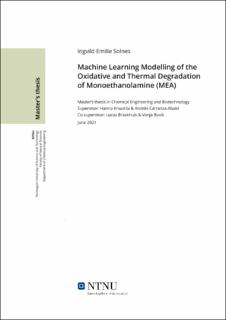| dc.contributor.advisor | Knuutila, Hanna | |
| dc.contributor.advisor | Carranza-Abaid, Andrés | |
| dc.contributor.advisor | Braakhuis, Lucas | |
| dc.contributor.advisor | Buvik, Vanja | |
| dc.contributor.author | Solnes, Ingvild | |
| dc.date.accessioned | 2022-01-27T18:20:13Z | |
| dc.date.available | 2022-01-27T18:20:13Z | |
| dc.date.issued | 2021 | |
| dc.identifier | no.ntnu:inspera:82941058:18449115 | |
| dc.identifier.uri | https://hdl.handle.net/11250/2902916 | |
| dc.description.abstract | Folketallet i verden vokser, noe som fører til en økning i forbruket av ressurser og utslipp av klimagasser. Som et resultat av dette øker konsentrasjonene av klimagasser i atmosfæren til farlige nivåer, og behovet for tiltak for å redusere utslippene øker. Ett tiltak som kan redusere utslipp er CO2-fangst og lagring, som åpner mulighetene for å fjerne CO2 fra røykgass, komprimere og lagre det i stedet for å slippe den ut i atmosfæren.
Et eksempel på en CO2-fangstteknologi er kjemisk absorbsjon med aminbasert solvent. Med denne teknologien er det også utfordringer, hovedsakelig degradering av solventen. Ytterligere forståelse av degradering er viktig for å redusere driftskostnader, kontroll av solventen og utslippskontroll.
I denne oppgaven har hovedfokuset vært på oksidativ og termisk degradering av monoetanolamin (MEA), som er et det absorbsjonskjemikaliet som er forsket mest på innen kjemisk absorbsjon. Matematisk maskinlæringsmodellering har blitt brukt til å lage en prediktiv modell som kan beskrive degradering og trender i eksperimentelle data. Målet med arbeidet har vært å se om maskinlæringsmodellering har potensial til å gi gode modellforutsigelser, beskrive degradering av MEA og dannelsen av utvalgte degraderingsforbindelser.
For de oksidative degraderingsmodellene ble det utviklet to modeller. Den første modellen hadde 3 inputs (MEA-konsentrasjon, oksygenkonsentrasjon, temperatur) og den andre modellen hadde 10 eller 11 inputs, og inkluderte eksperimentelle data fra de andre målte degraderingsproduktene. Dette ble gjort for å se om de modellerte resultatene ville forbedres med flere inputs til modellen. Output fra modellene var den beregnede eksperimentelle reaksjonshastigheten. For modellene for termisk degradering ble det også utviklet to modeller. Her var det en modell med 3 inputs (MEA-konsentrasjon, CO2-loading, temperatur) og en med 6 inputs, som inkluderte de andre målte degraderingsproduktene.
Fra resultatene ser modellene ut til å være i stand til å fange trenden til den eksperimentelle dataen. Modellene er datadrevne, og krever derfor eksperimentell data. Modellen ser ut til å være følsom for avvikende verdier i datasettene, og kan anvendes til å identifisere avvikere i eksperimentelle data. Resultatene er lovende for videre modellering, og med mer forskning og eksperimentelle data, bør modellprediksjonene lett forbedres. | |
| dc.description.abstract | The human population is growing, leading to increased consumption of resources and emission of greenhouse gases. As a result, the concentration of greenhouse gases in the atmosphere is rising to dangerous levels, and the need for measures to reduce emissions is growing. One measure is CO2-capture and storage, which opens up the possibility of removing CO2 from flue gas, compressing and storing it instead of emitting it to the atmosphere.
One example of a CO2-capture technology is chemical absorption with an amine-based solvent. With this technology, there are also difficulties, mainly degradation of the solvent. Therefore, further understanding of degradation is important for reducing operational costs, solvent management and emission control.
In this thesis, the main focus has been on oxidative and thermal degradation of monoethanolamine (MEA), one of the most researched solvents for chemical absorption. Mathematical machine learning modelling has been used to make a predictive model that can describe the degradation and trends in experimental data. The objective of the work has been to see if machine learning modelling has the potential to give good model predictions, describe the degradation of MEA and the formation of selected degradation compounds.
For the oxidative degradation models, two models were developed. The first model had 3 inputs (MEA-concentration, oxygen concentration, temperature), and the second model had 10 or 11 inputs that included experimental data from the other measured degradation products. This was done to see if the modelled results would improve with more inputs to the model. The output was the calculated experimental reaction rate. For the thermal degradation models, two models were also developed. Here, there was one model with 3 inputs (MEA-concentration, CO2-loading, temperature) and one with 6 inputs that included the other measured degradation products.
From the results, the models seem to be able to capture the trend of the experimental data. The models are data-driven, hence requiring a lot of experimental data. However, the model seems to be sensitive to outliers in the datasets so that the models can identify outliers in experimental data. The results are promising for further modelling, and with more research and more experimental data, the model predictions should quickly improve. | |
| dc.language | eng | |
| dc.publisher | NTNU | |
| dc.title | Machine Learning Modelling of the Oxidative and Thermal Degradation of Monoethanolamine (MEA) | |
| dc.type | Master thesis | |
